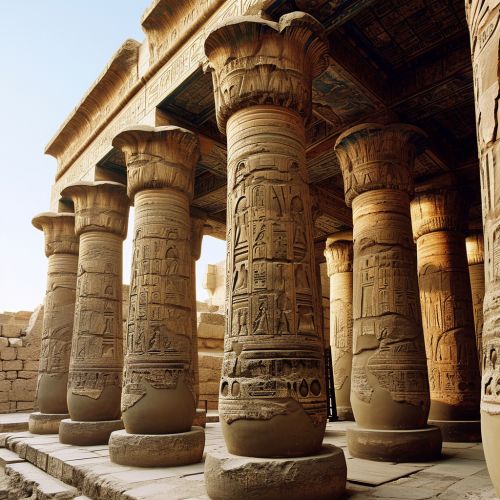Egyptian temple
Architecture
Egyptian temples were designed and built according to a set of sacred architectural rules that were believed to connect the earth and the divine. These structures were primarily built to honor the gods and provide a place for them to interact with humans. The architecture of these temples was complex and included several key elements such as pylons, courtyards, hypostyle halls, sanctuaries, and obelisks.


The entrance to the temple was usually marked by a pair of towering pylons. These monumental gateways, often adorned with reliefs and inscriptions, represented the mountains of the horizon between which the sun rose and set. Beyond the pylons, there was a large open courtyard surrounded by colonnades. This was a public space where rituals and festivals were held.
The courtyard led to the hypostyle hall, a vast, column-filled space that served as the temple's main interior. The columns, often carved with hieroglyphs and religious iconography, supported a roof that was designed to represent the sky. The hall was dimly lit, creating a stark contrast to the bright sunlight of the courtyard and enhancing the sense of mystery and sacredness.
At the heart of the temple was the sanctuary, a small, dark room that housed the statue of the temple's deity. This was the most sacred part of the temple, accessible only to the high priest and the pharaoh. The sanctuary was often located at the end of a long, straight axis that ran through the center of the temple, symbolizing the path of the sun.
In addition to these main elements, Egyptian temples often featured obelisks, tall, four-sided pillars topped with a pyramidion. These obelisks were monolithic in nature, carved from a single piece of stone, and were often placed in pairs at the entrance of the temples.
Function
Egyptian temples served as the homes of the gods, where rituals and offerings were made to ensure the continued favor of the deities. They were also centers of economic, political, and social activity. The temples owned vast amounts of land and employed thousands of people, including priests, scribes, artisans, and laborers.
The main function of the temple was to serve as a place for the god to reside on earth. Each day, priests performed rituals to care for the god, which included clothing, feeding, and praising the deity. These rituals were believed to sustain the god and maintain ma'at, the divine order of the universe.
Temples also played a key role in festivals, which were important events in the Egyptian calendar. The most significant of these was the Opet Festival, during which the statues of the gods were paraded from the temple of Karnak to the temple of Luxor.
In addition to their religious functions, temples were also centers of learning. They housed libraries and schools where scribes and priests were trained. They were also involved in healthcare, with many temples having a dedicated area for healing known as the House of Life.
Construction
The construction of an Egyptian temple was a massive undertaking that required careful planning and significant resources. The process began with the selection of a suitable site, which was often chosen for its symbolic or strategic significance. Once the site was chosen, the pharaoh would perform the foundation rituals, which included the 'stretching of the cord' ceremony to determine the temple's layout.
The temples were built using stone, a material that was both durable and symbolic of eternity. The most commonly used stones were limestone and sandstone, although granite and basalt were also used for certain elements such as obelisks and statues. The stones were quarried and transported to the site, where they were shaped and assembled into the temple structure.
The construction of the temple was overseen by a team of architects, engineers, and scribes, who ensured that the sacred architectural rules were followed. The work was carried out by skilled artisans and laborers, who were often employed by the temple.
Once the construction was completed, the temple was decorated with reliefs and inscriptions that depicted the pharaoh making offerings to the gods. These decorations were not merely decorative, but served to legitimize the pharaoh's rule and demonstrate his piety.
Preservation and Legacy
Many Egyptian temples have survived to the present day, providing valuable insights into the religious, social, and political life of ancient Egypt. These temples are considered architectural masterpieces and are popular tourist destinations.
The preservation of these temples has been a priority for both the Egyptian government and international organizations. Efforts to preserve these sites include regular maintenance, restoration of damaged structures, and measures to protect the temples from environmental threats.
The legacy of Egyptian temples extends beyond their architectural and historical significance. They have influenced the design of buildings in other cultures and periods, and have contributed to our understanding of ancient Egyptian religion and society.
